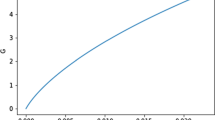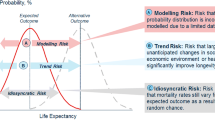Abstract
We study asset demands and consumption of an individual with longevity risk. We investigate a complete market with vehicles hedging against longevity risk and compare this case with a no insurance case and a partial insurance case to illustrate comprehensive economic implications. Particularly, we show that the stock-to-savings ratio in the partial insurance case is smaller than that in the other two cases, and that the time-old proposition, such that an increased mortality rate is equivalent to an increased subjective discount rate, does not necessarily follow without the assumption of a time-separable utility function.




Similar content being viewed by others
Notes
The data are contained in the ‘Cohort Life Expectancy’ table in The 2007 Annual Report of The Board of Trustees of the Federal Old-Age and Survivors Insurance and Federal Disability Insurance Trust Funds.
Davidoff et al. (2005) proposed an ideal market where all the Arrow–Debreu-type insurance products are available. They, however, did not discuss investments in risky assets.
Vissing-Jørgensen (2002) has shown that the EIS for stockholders is larger than classical estimates and may exceed 1.
Barro and Friedman’s study (1977) seems closely related to our present work. They show that longevity risk does not reduce an individual’s utility level if perfect insurance is available. But if there exists human capital investments against which no mortality-contingent claims are available, then higher longevity risk can reduce both the individual’s utility and investment in human capital. However, they have not proposed an ideal complete market and studied portfolio selection between marketable assets.
Therefore, by abuse of notation, u or d can denote either a return or an event.
There is some evidence that the mortality rate is higher during economic expansions than during recessions (Ruhm 2000; Neumayer 2004; Granados 2005). This might imply \(\delta _u >\delta _d\). However, the evidence is for the general public and not specifically for stockholders and we will frequently assume \(\delta _u=\delta _d\) in our paper for theoretical analysis.
Here we make a simplified assumption that the individual does not make a portfolio choice between the stock and the risk-free asset at time 1. Since she knows for certain she will die at time 2, there is no longevity risk at time 1, and thus, the assumption does not affect our results qualitatively.
This is related to the fact that death does not require any more resource and is a bliss if RRA \(>\)1. For the case \(\psi =\displaystyle \frac{1}{\gamma }\), the fact can be easily observed from the ordinally equivalent formulation of the utility function \(\displaystyle \frac{c_t^{1-\gamma }}{1-\gamma } + \beta E_t \displaystyle \frac{U_{t+1}^{1-\gamma }}{1-\gamma }\), since the period utility functions are negative.
The quantity \(\hat{\varDelta }\) admits the following interpretation: In a standard binomial model with no mortality-contingent states, the risk-neutral probability of event u is equal to \(\tilde{\pi }_u\) (see, e.g., Hull 2009). The weighted average of real probabilities \(\pi _{uL}\) and \(\pi _{uD}\) by using utility weights \(\kappa _1^\alpha \) and \(\zeta \) is equal to \(\pi _u^1\), and this weighted average can be regarded as the individual’s subjective probability of event u in the absence of longevity insurance. Therefore, the ratio \(\displaystyle \frac{\tilde{\pi }_u}{\pi _u^1}\) can be called the event price density of u, considering the standard definition of the state price density of a state as the ratio of the risk-neutral probability to the real probability of the state. Similarly, the ratio \(\displaystyle \frac{\tilde{\pi }_d}{\pi _d^1}\) can be called the event price density of d. Then, \(\hat{\varDelta }\) is the ratio of these event price densities and can be called the relative price density of u with respect to d (or u and d’s relative price density).
\(\tilde{\delta }_i := \displaystyle \frac{\tilde{\pi }_{iD}}{\tilde{\pi }_i} = \displaystyle \frac{\tilde{\pi }_{iD}}{\tilde{\pi }_{iL}+\tilde{\pi }_{iD}}\) for \(i=u,d\). See “Optimal consumption and asset demands in the frictionless complete market and the Proof of Theorem 3” of Appendix for details.
Cannon and Tonks (2006) report that in the UK, for instance, the market for equity-linked annuities is still small and level annuities, which are similar to bonds, are prevalent type of annuities. This would be due to higher costs of providing other types of annuities such as equity-linked annuities.
In the USA and many other nations people tend to hold equities which have appreciated in value in order to defer capital gains tax payments. In these nations the tax deferral motive seems to provide a countervailing force against the reduction of the demand due to partial completion.
We thank an anonymous reviewer for providing this insightful interpretation.
This assumption is made to simplify analysis and does not affect the conclusions qualitatively.
By utilizing an argument similar to that for the other cases, the reader can prove the theorem. The proof will be given upon request.
Sources: Salomon Smith Barney 3-month T-bill index, Bureau of Labor Statistics.
The values of RRA \(\gamma \) and EIS \(\psi \) are selected based on existing studies. Guvenen (2006) argues that there are opposing views about EIS whether the value is close to zero or to one in previous studies and gives explanation to reconcile the heterogeneity using a real business cycle model. Bansal and Yaron (2004) utilize RRA of 10 and EIS of 1.5 for preference parameters. Vissing-Jørgensen and Attanasio (2003) find EIS estimates for stockholders are above 1 and RRA estimates range from 5 to 10.
To conserve space, we do not include the figure of optimal consumption–wealth ratio with positive bequest motive in the paper. The figure is available upon request.
References
Bansal, R., Yaron, A.: Risks for the long run: a potential resolution of asset pricing puzzles. J. Fiananc. 59, 1481–1809 (2004)
Barro, R.J., Friedman, J.W.: On uncertain lifetimes. J. Polit. Econ. 85, 843–849 (1977)
Campbell, J., Viceira, L.M.: Consumption and portfolio decisions when expected returns are time varying. Q. J. Econ. 114, 433–495 (1999)
Cannon, E., Tonks, I.: Survey of Annuity Pricing. Department for Work and Pensions of UK Research Report, vol. 318, No. 318. Department for Work and Pensions, London (2006)
Cochrane, J.H.: Asset Pricing. Princeton University Press, Princeton (2001)
Cocco, J.F., Gomes, F.J.: Longevity risk. J. Financ. Econ. 103, 507–529 (2012)
Davidoff, T., Brown, J.R., Diamond, P.A.: Annuities and individual welfare. Am. Econ. Rev. 95, 1573–1590 (2005)
Davies, J.B.: Uncertain lifetime, consumption, and dissaving in retirement. J. Polit. Econ. 89, 561–577 (1981)
De Nardi, M.: Wealth inequality and intergenerational links. Rev. Econ. Stud. 71, 743–768 (2004)
De Nardi, M., French, E., Jones, J.B.: Why do the elderly save? The role of medical expenses. J. Polit. Econ. 118, 39–75 (2010)
Dybvig, P.H., Liu, H.: Lifetime consumption and investment: retirement and constrained borrowing. J. Econ. Theory 145, 885–907 (2010)
Dybvig, P.H., Ross, S.A.: Arbitrage, state prices, and portfolio theory. In: Constantinides, G.M., Harris, M., Stulz, R.M. (eds.) Handbook of the Economics of Finance, pp. 605–637. Elsevier, Amsterdam (2003)
Epstein, L.G., Zin, S.E.: Substitution, risk aversion and the temporal behavior of consumption and asset returns: a theoretical framework. Econometrica 57, 937–969 (1989)
Epstein, L.G., Zin, S.E.: Substitution, risk aversion and the temporal behavior of consumption and asset returns: an empirical analysis. J. Polit. Econ. 99, 263–286 (1991)
Friend, I., Blume, M.E.: The demand for risky assets. Am. Econ. Rev. 65, 900–922 (1975)
Gomes, F., Michaelides, A.: Optimal life-cycle asset allocation: understanding the empirical evidence. J. Financ. LX, 869–904 (2005)
Granados, J.A.T.: Increasing mortality during the expansions of the US economy. Int. J. Epidemiol. 34, 1194–1202 (2005)
Guvenen, F.: Reconciling conflicting evidence on the elasticity of intertemporal substitution: a macroeconomic perspective. J. Monet. Econ. 53, 1451–1472 (2006)
Hull, J.C.: Options, Futures, and Other Derivatives. Pearson Education International, Pearson (2009)
Hurd, M.D.: Research on the elderly: economic status, retirement, and consumption and saving. J. Econ. Lit. 28, 565–637 (1990)
Hurd, M.D.: Mortality risk and bequests. Econometrica 4, 779–813 (1989)
Inkmann, J., Lopes, P., Michaelides, A.: How deep is the annuity market participation puzzle? Rev. Financ. Stud. 24, 279–319 (2011)
Kopczuk, W., Lupton, J.P.: To leave or not to leave: the distribution of bequest motives. Rev. Econ. Stud. 74, 207–235 (2007)
Kreps, D.M., Porteus, E.L.: Temporal resolution of uncertainty and dynamic choice theory. Econometrica 46, 185–200 (1978)
Lee, L.M.: Bequest motives and the annuity puzzle. Rev. Econ. Dyn. 15, 226–243 (2012)
Merton, R.C.: Lifetime portfolio selection under uncertainty: the continuous-time case. Rev. Econ. Stat. 51, 247–257 (1969)
Milevsky, M.A., Young, V.R.: Annuitization and asset allocation. J. Econ. Dyn. Control 31, 3138–3177 (2007)
Mitchell, O.S., Poterba, J.M., Warshawsky, M.J., Brown, J.R.: The new evidence on the money’s worth of individual annuities. Am. Econ. Rev. 89, 1299–1318 (1999)
Neumayer, E.: Recessions lower (some) mortality rates: evidence from Germany. Soc. Sci. Med. 58, 1037–1047 (2004)
Philipson, T.J., Becker, G.S.: Old-age longevity and mortality-contingent claims. J. Polit. Econ. 106, 551–573 (1998)
Prettner, K., Canning, D.: Increasing life expectancy and optimal retirement in general equilibrium. Econ. Theory 56, 191–217 (2014)
Richard, S.F.: Optimal consumption, portfolio and life insurance rules for an uncertain lived individual in a continuous time model. J. Financ. Econ. 2, 187–203 (1975)
Ruhm, C.J.: Are recessions good for your health? Q. J. Econ. 115, 617–650 (2000)
Svensson Lars, E.O.: Portfolio choice with non-expected utility in continuous time. Econ. Lett. 30, 313–317 (1989)
Szpiro, G.G.: Measuring risk aversion: an alternative approach. Rev. Econ. Stat. 68, 156–159 (1986)
Vissing-Jørgensen, A.: Limited asset market participation and the elasticity of intertemporal substitution. J. Polit. Econ. 110, 825–853 (2002)
Vissing-Jørgensen, A., Attanasio, O.P.: Stock-Market participation, intertemporal substitution, and risk-aversion. Am. Econ. Rev. 93, 383–391 (2003)
Weil, P.: Nonexpected utility in macroeconomics. Q. J. Econ. 105, 29–42 (1990)
Yaari, M.E.: Uncertain lifetime, life insurance and the theory of the consumer. Rev. Econ. Stud. 32, 137–150 (1965)
Yogo, M.: Portfolio Choice in Retirement: Health Risk and the Demand for Annuities, Housing, and Risky Assets. NBER working paper no. 7399. National Bureau of Economic Research, Cambridge (2009)
Author information
Authors and Affiliations
Corresponding author
Additional information
We thank John Y. Campbell, Jin-Chuan Duan, Philip H. Dybvig, Hong Liu, Jun Liu, Mark Loewenstein, Chenghu Ma, Gyoocheol Shim, Jaeyoung Sung, Shanjian Tang, Dong Chul Won for useful comments and conversations. Preliminary versions of the paper were presented at the 2009 China International Conference in Finance, the Risk Management Institute of Singapore National University, the Institute for Financial Studies of Southwestern University of Finance and Economics in China, and the 2010 Co-conference in Finance of Korea. This research was supported by WCU (World Class University) program (R31-20007), by the National Research Foundation of Korea Grant funded by the Korean government (NRF-2014S1A3A2036037), and by Basic Science Research Program (NRF-2012R1A1A2038735, NRF-2013R1A2A2A03068890) through the National Research Foundation of Korea funded by the Ministry of Education, Science and Technology.
Rights and permissions
About this article
Cite this article
Jang, BG., Koo, H.K. & Rhee, Y. Asset demands and consumption with longevity risk. Econ Theory 62, 587–633 (2016). https://doi.org/10.1007/s00199-015-0922-7
Received:
Accepted:
Published:
Issue Date:
DOI: https://doi.org/10.1007/s00199-015-0922-7




